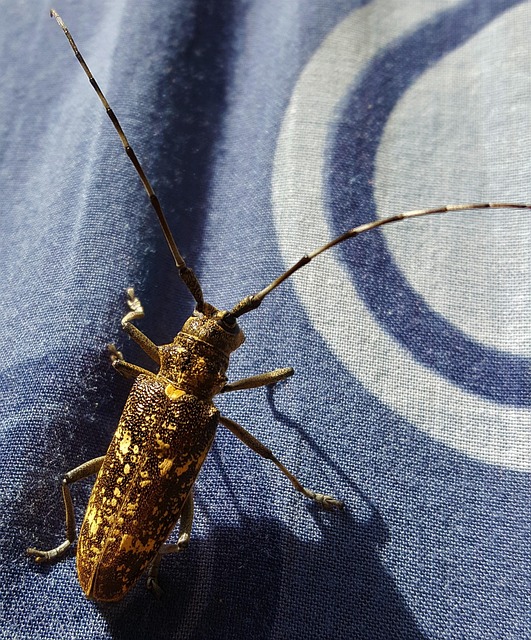Cricket infestations in homes are caused by food, moisture, and warm temperatures, with house crickets, field crickets, and carpet beetles common culprits. Effective residential cricket removal requires a thorough assessment to identify species and locate nests. Professionals use this information to deploy targeted treatments, seal entry points, and disrupt the crickets' life cycle. Preventing future infestations involves regular cleaning, sealing gaps, and using long-lasting pest control products for ongoing protection.
Cricket infestations can turn your home into a chaotic labyrinth, causing distress and damage. Understanding these severe residential cricket issues is crucial for effective removal. This article delves into the common types and causes of cricket infestations in homes, providing an in-depth guide to assessment, specialized control strategies, and long-term prevention. Learn about residential cricket removal methods tailored to specific needs, ensuring a peaceful and pest-free environment.
Understanding Residential Cricket Infestations: Common Types and Causes
Cricket infestations in residential areas can be a significant nuisance, causing distress and disrupting daily life. Understanding these infestations is the first step towards effective residential cricket removal. The most common types include the house cricket, field cricket, and carpet beetle. These insects are often attracted to homes by food sources, moisture, and warm temperatures.
Various factors contribute to cricket infestations, such as poor ventilation, clutter, and gaps around doors or windows. Once inside, they rapidly reproduce, with females laying eggs in cracks and crevices, leading to a quick multiplication of the pest population. Identifying the specific type of cricket is crucial as it determines the best approach for removal and prevention.
Assessment and Identification: The First Steps in Cricket Removal
When dealing with a severe cricket infestation, the initial steps involve thorough assessment and identification. This crucial process begins with a comprehensive inspection of the affected areas within residential properties. Skilled professionals employ various techniques to locate active cricket nests, identify species, and understand the extent of the invasion. Visual signs like visible crickets, egg cases, or molted exoskeletons serve as initial indicators, but trained eyes are essential for accurate identification.
Effective residential cricket removal starts with this detailed assessment because it determines the most suitable control methods. Different species may require distinct approaches, from targeted treatments to complete eradication strategies. By understanding the cricket’s behavior, habitat, and life cycle, professionals can implement tailored solutions aimed at disrupting their reproduction and movement patterns, ultimately leading to a pest-free environment.
Specialized Solutions: Effective Strategies for Cricket Control
When dealing with severe cricket infestations, specialized solutions are essential for effective cricket control in both commercial and residential settings. Professional pest control services offer tailored strategies that go beyond standard measures. These include identifying and sealing entry points to prevent further invasion, as crickets can enter through tiny cracks or gaps around windows, doors, and utility pipes. Targeted treatments using eco-friendly chemicals or biological agents are deployed to eliminate existing cricket populations while minimizing environmental impact.
Residential cricket removal requires a multi-faceted approach. Regular inspections help in early detection of infestations. Maintaining a clean and clutter-free environment reduces hiding spots for crickets. Professional exterminators also employ heat treatments, which use targeted warmth to disrupt the crickets’ life cycle, making them effective game changers against stubborn infestations. These specialized solutions ensure that homes remain cricket-free, providing residents with lasting peace of mind.
Long-term Prevention: Safeguarding Your Space Post-Infestation
After successfully addressing a severe cricket infestation through professional residential cricket removal services, ensuring long-term prevention is crucial to safeguard your space. This involves implementing robust measures to prevent future infestations from occurring. One effective strategy is maintaining excellent hygiene and cleanliness, as crickets are attracted to organic debris and garbage. Regularly cleaning your home, particularly in areas where crickets breed, such as dark corners, attics, and basements, can significantly reduce their population.
Additionally, sealing entry points like gaps in walls, windows, and doors is essential. Crickets can easily penetrate small openings, so using caulk or other sealing materials to block these access points prevents them from reentering your home. Using pest control products specifically designed for cricket prevention, such as insecticides with long-lasting residuals, can also be beneficial. Professional services often recommend seasonal treatments to ensure ongoing protection against future infestations, providing peace of mind and a cricket-free environment for years to come.
When dealing with severe cricket infestations, a comprehensive approach is key. By understanding the types and causes of these pests in residential areas, conducting thorough assessments, and employing specialized solutions tailored to your specific situation, you can effectively manage and prevent future cricket removal challenges. Remember, proactive long-term prevention measures are crucial for safeguarding your space from these persistent intruders.
